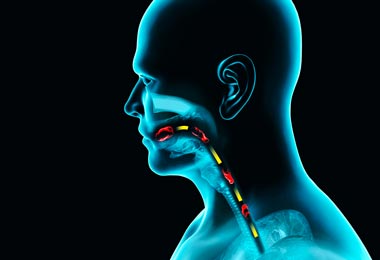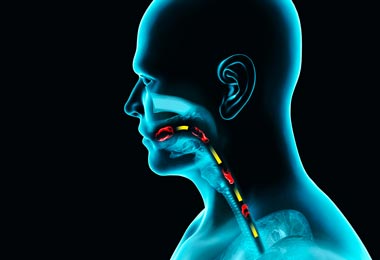Stomach and Duodenal Ulcers (Peptic Ulcers)
What is a peptic ulcer?
A peptic ulcer is a sore on the lining of your stomach or the first part of your small intestine (duodenum). If the ulcer is in your stomach, it is called a gastric ulcer. If the ulcer is in your duodenum, it is called a duodenal ulcer.
Ulcers are fairly common.
What causes peptic ulcers?
In the past, experts thought lifestyle factors such as stress and diet caused ulcers. Today we know that stomach acids and other digestive juices help create ulcers. These fluids burn the linings of your organs.
Causes of peptic ulcers include:
- H. pylori bacteria (Helicobacter pylori). Most ulcers are caused by an infection from a bacteria or germ called H. pylori. This bacteria hurts the mucus that protects the lining of your stomach and the first part of your small intestine (the duodenum). Stomach acid then gets through to the lining.
- NSAIDs (nonsteroidal anti-inflammatory drugs). These are over-the-counter pain and fever medicines such as aspirin, ibuprofen, and naproxen. Over time they can damage the mucus that protects the lining of your stomach.
What are the symptoms of peptic ulcers?
Each person’s symptoms may vary. In some cases ulcers don’t cause any symptoms.
The most common ulcer symptom is a dull or burning pain in your belly between your breastbone and your belly button (navel). This pain often occurs around meal times and may wake you up at night. It can last from a few minutes to a few hours.
Less common ulcer symptoms may include:
- Feeling full after eating a small amount of food
- Burping
- Nausea
- Vomiting
- Not feeling hungry
- Losing weight without trying
- Bloody or black stool
- Vomiting blood
Peptic ulcer symptoms may look like other health problems. Always see your healthcare provider to be sure.
How are peptic ulcers diagnosed?
Your healthcare provider will look at your past health and give you a physical exam. You may also have some tests.
Imaging tests used to diagnose ulcers include:
- Upper GI (gastrointestinal) series or barium swallow. This test looks at the organs of the top part of your digestive system. It checks your food pipe (esophagus), stomach, and the first part of the small intestine (the duodenum). You will swallow a metallic fluid called barium. Barium coats the organs so that they can be seen on an X-ray.
- Upper endoscopy or EGD (esophagogastroduodenoscopy). This test looks at the lining of your esophagus, stomach, and duodenum. It uses a thin lighted tube called an endoscope. The tube has a camera at one end. The tube is put into your mouth and throat. Then it goes into your esophagus, stomach, and duodenum. Your health care provider can see the inside of these organs. A small tissue sample (biopsy) can be taken. This can be checked for H. pylori.
You may also have the following lab tests to see if you have an H. pylori infection:
- Blood tests. These check for infection-fighting cells (antibodies) that mean you have H. pylori.
- Stool culture. A small sample of your stool is collected and sent to a lab. In 2 or 3 days, the test will show if you have H. pylori.
- Urea breath test. This checks to see how much carbon dioxide is in your breath when you exhale. You will swallow a urea pill that has carbon molecules. If you have H. pylori, the urea will break down and become carbon dioxide. You will have a sample taken of your breath by breathing into a bag. It will be sent to a lab. If your sample shows higher than normal amounts of carbon dioxide, you have H. pylori.
How are peptic ulcers treated?
Treatment will depend on the type of ulcer you have. Your healthcare provider will create a care plan for you based on what is causing your ulcer.
Treatment can include making lifestyle changes, taking medicines, or in some cases having surgery.
Lifestyle changes may include:
- Not eating certain foods. Avoid any foods that make your symptoms worse.
- Quitting smoking. Smoking can keep your ulcer from healing. It is also linked to ulcers coming back after treatment.
- Limiting alcohol and caffeine. They can make your symptoms worse.
- Not using NSAIDs (non-steroidal anti-inflammatory medicines). These include aspirin and ibuprofen.
Medicines to treat ulcers may include:
- Antibiotics. These bacteria-fighting medicines are used to kill the H. pylori bacteria. Often a mix of antibiotics and other medicines is used to cure the ulcer and get rid of the infection.
- H2-blockers (histamine receptor blockers). These reduce the amount of acid your stomach makes by blocking the hormone histamine. Histamine helps to make acid.
- Proton pump inhibitors or PPIs. These lower stomach acid levels and protect the lining of your stomach and duodenum.
- Mucosal protective agents. These medicines protect the stomach's mucus lining from acid damage so that it can heal.
- Antacids. These quickly weaken or neutralize stomach acid to ease your symptoms.
In most cases, medicines can heal ulcers quickly. Once the H. pylori bacteria is removed, most ulcers do not come back.
In rare cases, surgery may be needed if medicines don’t help. You may also need surgery if your ulcer causes other medical problems.
What are the complications of peptic ulcers?
Ulcers can cause serious problems if you don’t get treatment.
The most common problems include:
- Bleeding. As an ulcer wears away the muscles of the stomach or duodenal wall, blood vessels may be hurt. This causes bleeding.
- Hole (perforation). Sometimes an ulcer makes a hole in the wall of your stomach or duodenum. When this happens, bacteria and partly digested food can get in. This causes infection and redness or swelling (inflammation).
- Narrowing and blockage (obstruction). Ulcers that are found where the duodenum joins the stomach can cause swelling and scarring. This can narrow or even block the opening to the duodenum. Food can’t leave your stomach and go into your small intestine. This causes vomiting. You can’t eat properly.
When should I call my healthcare provider?
See your healthcare provider right away if you have any of these symptoms:
- Vomiting blood or dark material that looks like coffee grounds
- Extreme weakness or dizziness
- Blood in your stools (your stools may look black or like tar)
- Nausea or vomiting that doesn’t get better, or gets worse
- A sudden, severe pain that may spread to your back
- Losing weight without even trying
Untreated peptic ulcers may cause other health problems. Sometimes they bleed. If they become too deep, they can break through your stomach.
Ulcers can also keep food from going through your stomach.
Key points
- These ulcers are sores on the lining of your stomach or the first part of your small intestine (the duodenum).
- Stomach acids and other digestive juices help to make ulcers by burning the linings of these organs.
- Most ulcers are caused by infection from a bacteria or germ called H. pylori (Helicobacter pylori) or from using pain killers called NSAIDs.
- The most common symptom is a dull or burning pain in the belly between the breastbone and the belly button.
- Ulcers can be treated with a mix of lifestyle changes and medicines. In rare cases, surgery is needed.
Next steps
Tips to help you get the most from a visit to your healthcare provider:
- Know the reason for your visit and what you want to happen.
- Before your visit, write down questions you want answered.
- Bring someone with you to help you ask questions and remember what your provider tells you.
- At the visit, write down the name of a new diagnosis, and any new medicines, treatments, or tests. Also write down any new instructions your provider gives you.
- Know why a new medicine or treatment is prescribed, and how it will help you. Also know what the side effects are.
- Ask if your condition can be treated in other ways.
- Know why a test or procedure is recommended and what the results could mean.
- Know what to expect if you do not take the medicine or have the test or procedure.
- If you have a follow-up appointment, write down the date, time, and purpose for that visit.
- Know how you can contact your provider if you have questions.






